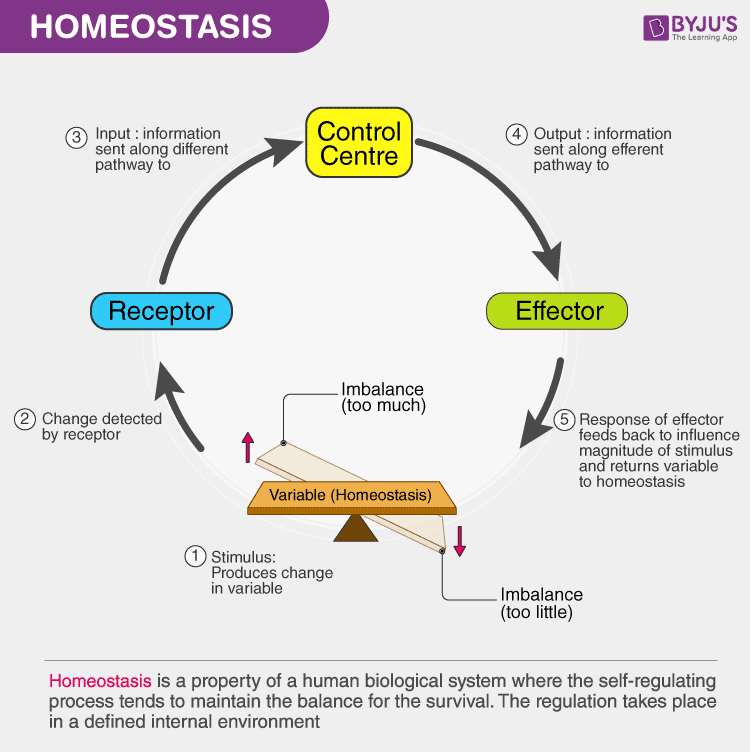Homeostasis Definition
“Homeostasis is the state of steady internal chemical and physical conditions maintained by living systems.”
Table of Contents
Homeostasis Meaning and Etymology
The theory of homeostasis was first introduced by Claude Bernard, a French Physiologist in the year 1865, and the term was first used in 1926 by Walter Bradford Cannon. Bradford derived Homeostasis from the ancient Greek words ὅμοιος (pronounced: hómoios) and ἵστημι (pronounced: hístēmi). The combination of these words translates to “similar” and “standing still” respectively.

Homeostasis Definition
Read on to explore what is homeostasis and its role in regulating internal body environment.
What is Homeostasis?
Homeostasis is quite crucial for the survival of organisms. It is often seen as a resistance to changes in the external environment. Furthermore, homeostasis is a self-regulating process that regulates internal variables necessary to sustain life.
In other words, homeostasis is a mechanism that maintains a stable internal environment despite the changes present in the external environment.
The body maintains homeostasis by controlling a host of variables ranging from body temperature, blood pH, blood glucose levels to fluid balance, sodium, potassium and calcium ion concentrations.
Regulation of Homeostasis
The regulation of homeostasis depends on three mechanisms:
- Effector.
- Receptor.
- Control Center.
The entire process continuously works to maintain homeostasis regulation.
Receptor
As the name suggests, the receptor is the sensing component responsible for monitoring and responding to changes in the external or internal environment.
Control Center
The control centre is also known as the integration centre. It receives and processes information from the receptor.
Effector
The effector responds to the commands of the control centre. It could either oppose or enhance the stimulus.
| An Example of Homeostasis in Action | |
| Receptor | Cutaneous receptors of the skin. |
| Control centre | Brain. |
| Effector | Blood vessels and sweat glands in the skin. |
| The skin has receptors that detect changes in temperature. If the external temperature rises or drops below the equilibrium, the control centre sends signals to the blood vessels and sweat glands in our skin to react accordingly. If the temperature is too hot, the blood vessels dilate (vasodilation) and cause a drop in the body temperature. Moreover, sweat glands produce sweat to accompany vasodilation. If the external temperature is too cold, the blood vessels constrict (vasoconstriction) and enable the body to retain heat. | |
Also Read: Thermoregulation
Homeostasis Breakdown
The failure of homeostasis function in an internal environment will result in illnesses or diseases. In severe cases, it can even lead to death and disability.
Many factors can affect homeostasis. The most common are:
- Genetics.
- Physical condition.
- Diet and nutrition.
- Venoms and toxins.
- Psychological health.
- Side effects of medicines and medical procedures.
Body Systems and Homeostasis
The body system participates in maintaining homeostasis regulations. The purpose of the body system is to describe several controlling mechanisms where every system contributes to homeostasis.
Listed below are the tables which describe how different organs perform different functions to maintain the internal body environment.
| Formed Elements | |
| Name | Function |
| Platelets | It assists blood clotting. |
| Red blood cells | Helps in transporting hydrogen and oxygen ions. |
| White blood cells | It fights against infections. |
| Plasma | |
| Component | Function |
| Nutrients | Required for cellular metabolism. |
| Proteins | Create osmotic pressure, aids clotting, and helps buffer blood. |
| Hormones | Known as chemical messengers. |
| Water | Provides fluid environment. |
| Salts | Helps in metabolic activity and aids the buffer in blood. |
| Wastes | Produced by cellular metabolism. |
| Nervous System | |
| Central Nervous System | |
| Cerebrum | Consciousness, creativity, thoughts, morals, memory, etc. |
| Lower portions | Reception of sensory data, coordination of muscular activity, homeostasis. |
| Spinal cord | Automatic reflex actions. |
| Peripheral Nervous System | |
| Autonomic system | Cranial and spinal motor nerves that control internal organs. |
| Cranial nerves, spinal nerves | Carry sensory information to motor impulses from the CNS. |
| Major Endocrine Glands and Their Hormones | |
| Hormone | Function |
| Adrenal medulla | |
| Epinephrine and Norepinephrine | Stimulates fight or flight response |
| Adrenal cortex | |
| Glucocorticoids (e.g., cortisol) | Promotes gluconeogenesis |
| Mineralocorticoids (e.g., aldosterone) | Promotes sodium re-absorption by kidneys |
| Anterior pituitary | |
| Thyroid-stimulating hormones | Stimulates thyroid gland. |
| Adrenocorticotropic hormones | Stimulates adrenal cortex gland. |
| Gonadotropin hormones | Stimulates gonads. |
| Gonads | |
| Androgen (male) Estrogen and progesterone (female) | Promotes secondary sexual characteristics. |
| Hypothalamus | |
| Hypothalamic-releasing hormones | Regulates anterior pituitary hormones. |
| Posterior pituitary | |
| Anti-diuretic hormone | Promotes water reabsorption by kidneys. |
| Parathyroid | |
| Parathyroid hormone | Maintains blood calcium and phosphorus levels. |
| Thyroid | |
| Thyroid hormones | Increases metabolic rates. |
| Pancreas | |
| Insulin | Lowers blood sugar level. |
| Glucagon | Raises blood sugar level. |
Other Examples of Homeostasis
- Blood glucose homeostasis.
- Blood oxygen content homeostasis.
- Extracellular fluid pH homeostasis.
- Plasma ionized calcium homeostasis.
- Arterial blood pressure homeostasis.
- Core body temperature homeostasis.
- The volume of body water homeostasis.
- Extracellular sodium concentration homeostasis.
- Extracellular potassium concentration homeostasis.
- Blood partial pressure of oxygen and carbon dioxide homeostasis.
Also Read: Osmoregulation
Recommended Video:

Frequently Asked Questions
1. State homeostasis definition.
Homeostasis is the ability to maintain internal stability in an organism in response to the environmental changes. The internal temperature of the human body is the best example of homeostasis.
2. Which body systems help to maintain homeostasis?
The endocrine system and the nervous system are essential in maintaining the homeostasis of the body. However, other organs also play a role in maintaining homeostasis as well.
3. How is homeostasis essential for our body?
Homeostasis is a self-regulating process that controls internal variables necessary to sustain life.
4. What are the main components of homeostasis?
Homeostasis involves three components- the receptor, the control centre, and the effector. The receptor receives information on the changing environment, and the control centre processes the information received by the receptor. And the effector responds to the commands of the control centre by enhancing or opposing the stimulus.
5. What is the primary function of homeostasis?
The primary function of homeostasis is to maintain a balance within the body regarding its temperature, salt concentration, food intake and pH levels.
6. How does the cell maintain homeostasis in the body?
To maintain homeostasis in the body, the cells perform the following activities: Obtain and use energy, exchange materials, make new cells, and eliminate wastes.
7. What role does liver play in homeostasis?
Our liver plays a vital role in blood glucose homeostasis. When the blood glucose level rises after a meal, the liver removes glucose from the blood and stores it in the form of glycogen. When the blood glucose levels are low, it converts the stored glycogen back to glucose.
8. How does the skin help in maintaining homeostasis?
If the external temperature is high, the body tries to keep cool by producing sweat. Also, blood vessels near the skin surface dilate. This helps in decreasing body temperature. Conversely, if the external temperature is cold, the blood vessels constrict and retain body heat. Thus, the skin maintains homeostasis.

Comments